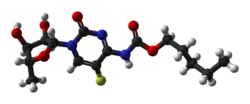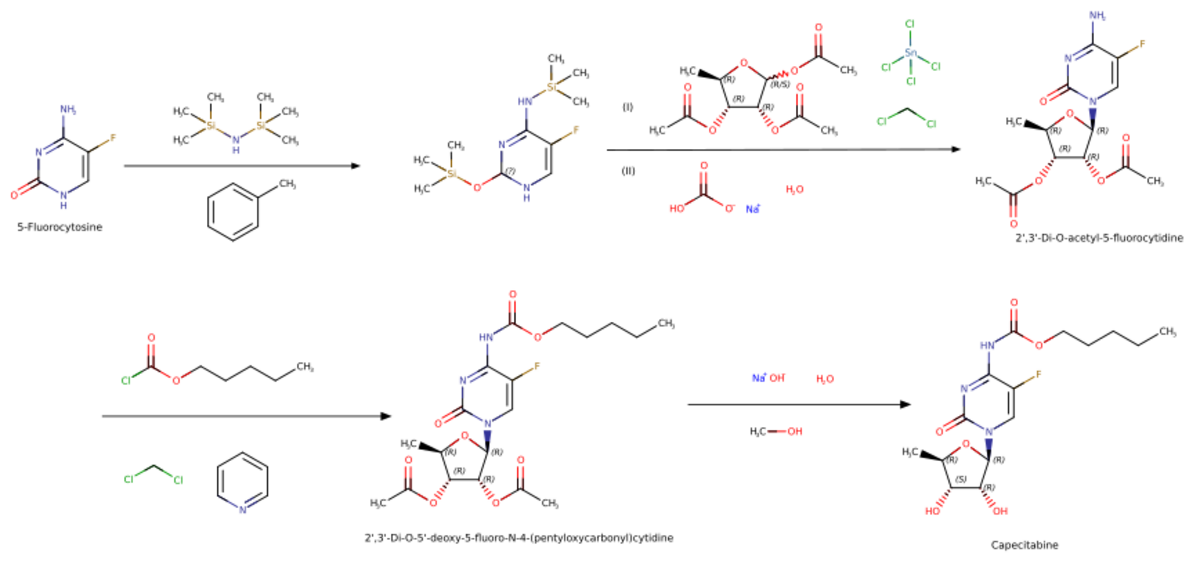Chemistry:Capecitabine
 | |
 | |
| Clinical data | |
|---|---|
| Pronunciation | /kæpɪˈsaɪtəbiːn/ |
| Trade names | Xeloda, Xitabin, Kapetral, others |
| AHFS/Drugs.com | Monograph |
| MedlinePlus | a699003 |
| License data | |
| Pregnancy category |
|
| Routes of administration | By mouth |
| Drug class | chemotherapy agent |
| ATC code | |
| Legal status | |
| Legal status | |
| Pharmacokinetic data | |
| Bioavailability | Extensive |
| Protein binding | < 60% |
| Metabolism | liver, to 5'-DFCR, 5'-DFUR (inactive); neoplastic tissue, 5'-DFUR to active fluorouracil |
| Elimination half-life | 38–45 minutes |
| Excretion | kidney (95.5%), faecal (2.6%) |
| Identifiers | |
| |
| CAS Number | |
| PubChem CID | |
| IUPHAR/BPS | |
| DrugBank | |
| ChemSpider | |
| UNII | |
| KEGG | |
| ChEBI | |
| ChEMBL | |
| Chemical and physical data | |
| Formula | C15H22FN3O6 |
| Molar mass | 359.354 g·mol−1 |
| 3D model (JSmol) | |
| |
| |
| (verify) | |
Capecitabine, sold under the brand name Xeloda among others, is a anticancer medication used to treat breast cancer, gastric cancer and colorectal cancer.[1] For breast cancer it is often used together with docetaxel.[2] It is taken by mouth.[2]
Common side effects include abdominal pain, vomiting, diarrhea, weakness, and rashes.[2] Other severe side effects include blood clotting problems, allergic reactions, heart problems such as cardiomyopathy, and low blood cell counts.[2] Use during pregnancy may result in harm to the fetus.[2] Capecitabine, inside the body, is converted to 5-fluorouracil (5-FU) through which it acts.[2] It belongs to the class of medications known as fluoropyrimidines, which also includes 5-FU and tegafur.[3]
Capecitabine was patented in 1992 and approved for medical use in 1998.[4] It is on the World Health Organization's List of Essential Medicines.[5]
Medical uses
Capecitabine is indicated for
- adjuvant treatment of people with Stage III colon cancer as a single agent or as a component of a combination chemotherapy regimen;[6]
- perioperative treatment of adults with locally advanced rectal cancer as a component of chemoradiotherapy;[6]
- treatment of people with unresectable or metastatic colorectal cancer as a single agent or as a component of a combination chemotherapy regimen;[6]
- treatment of people with advanced or metastatic breast cancer as a single agent if an anthracycline- or taxane-containing chemotherapy is not indicated;[6]
- treatment of people with advanced or metastatic breast cancer in combination with docetaxel after disease progression on prior anthracycline-containing chemotherapy;[6]
- treatment of adults with unresectable or metastatic gastric, esophageal, or gastroesophageal junction cancer as a component of a combination chemotherapy regimen;[6]
- treatment of adults with HER2-overexpressing metastatic gastric or gastroesophageal junction adenocarcinoma who have not received prior treatment for metastatic disease as a component of a combination regimen;[6]
- adjuvant treatment of adults with pancreatic adenocarcinoma as a component of a combination chemotherapy regimen.[6]
Adverse effects
Adverse effects by frequency:[7][8][9][10]
- Very common (>10% frequency)
- Appetite loss
- Diarrhea
- Vomiting
- Nausea
- Stomatitis
- Abdominal pain
- Fatigue
- Weakness
- Hand-foot syndrome[11]
- Oedema
- Fever
- Pain
- Headache
- Hair loss
- Dermatitis
- Indigestion
- Shortness of breath
- Eye irritation
- Myelosuppression[Note 1]
Notes on adverse effects:
- ↑ Includes: anaemia, lymphopenia, neutropenia and thrombocytopenia
Contraindications
Contraindications include:[9]
- History of hypersensitivity to fluorouracil, capecitabine or any of its excipients
- DPD deficiency (see Pharmacogenetics)
- Pregnancy and lactation
- Severe leucopenia, neutropenia, or thrombocytopenia
- Severe hepatic impairment or severe renal impairment
- Treatment with sorivudine or its chemically related analogues, such as brivudine
Drug interactions
Drugs it is known to interact with include:[9]
- Sorivudine or its analogues, such as, brivudine.
- CYP2C9 substrates, including, warfarin and other coumarin-derivatives anticoagulants
- Phenytoin, as it increases the plasma concentrations of phenytoin.
- Calcium folinate may enhance the therapeutic effects of capecitabine by means of synergising with its metabolite, 5-FU. It may also induce more severe diarrhoea by means of this synergy.[12]
Pharmacogenetics
The dihydropyrimidine dehydrogenase (DPD) enzyme is responsible for the detoxifying metabolism of fluoropyrimidines, a class of drugs that includes capecitabine, 5-fluorouracil and tegafur.[3] Genetic variations within the DPD gene (DPYD) can lead to reduced or absent DPD activity, and individuals who are heterozygous or homozygous for these variations may have partial or complete DPD deficiency; an estimated 0.2% of individuals have complete DPD deficiency.[3][13] Those with partial or complete DPD deficiency have a significantly increased risk of severe or even fatal drug toxicities when treated with fluoropyrimidines; examples of toxicities include myelosuppression, neurotoxicity and hand-foot syndrome.[3][13]
Mechanism of action
Capecitabine is metabolised to 5-FU which in turn is a thymidylate synthase inhibitor, hence inhibiting the synthesis of thymidine monophosphate (ThMP), the active form of thymidine which is required for the de novo synthesis of DNA.[14]
Drug synthesis
Society and culture
Brand names
One of the brand names is Xeloda, marketed by Genentech.
Others include Xitabin, Capcibin, Kapetral and Pecaset by Eurolab.
References
- ↑ British national formulary : BNF 69 (69 ed.). British Medical Association. 2015. pp. 585, 588. ISBN 9780857111562.
- ↑ 2.0 2.1 2.2 2.3 2.4 2.5 "Capecitabine". The American Society of Health-System Pharmacists. https://www.drugs.com/monograph/capecitabine.html.
- ↑ 3.0 3.1 3.2 3.3 "Clinical Pharmacogenetics Implementation Consortium guidelines for dihydropyrimidine dehydrogenase genotype and fluoropyrimidine dosing". Clinical Pharmacology and Therapeutics 94 (6): 640–645. December 2013. doi:10.1038/clpt.2013.172. PMID 23988873.
- ↑ Analogue-based Drug Discovery. John Wiley & Sons. 2006. p. 511. ISBN 9783527607495. https://books.google.com/books?id=FjKfqkaKkAAC&pg=PA511. Retrieved 30 August 2017.
- ↑ World Health Organization model list of essential medicines: 21st list 2019. Geneva: World Health Organization. 2019. WHO/MVP/EMP/IAU/2019.06. License: CC BY-NC-SA 3.0 IGO.
- ↑ 6.0 6.1 6.2 6.3 6.4 6.5 6.6 6.7 "FDA approves updated drug labeling including new indications and dosing regimens for capecitabine tablets under Project Renewal". 15 December 2022. https://www.fda.gov/drugs/resources-information-approved-drugs/fda-approves-updated-drug-labeling-including-new-indications-and-dosing-regimens-capecitabine.
 This article incorporates text from this source, which is in the public domain.
This article incorporates text from this source, which is in the public domain.
- ↑ "XELODA (capecitabine) tablet, film coated [Genentech, Inc."]. DailyMed. Genentech, Inc.. December 2013. http://dailymed.nlm.nih.gov/dailymed/lookup.cfm?setid=a1de8bba-3b1d-4c9d-ab8a-32d2c05e67c8.
- ↑ "Capecitabine Teva : EPAR – Product Information". European Medicines Agency. Teva Pharma B.V.. 10 January 2014. http://www.ema.europa.eu/docs/en_GB/document_library/EPAR_-_Product_Information/human/002362/WC500127288.pdf.
- ↑ 9.0 9.1 9.2 "Capecitabine 150mg – Summary of Product Characteristics (SPC)". electronic Medicines Compendium. Zentiva. 23 December 2013. http://www.medicines.org.uk/emc/medicine/28462/SPC/Capecitabine+150mg/.
- ↑ "NAME OF THE MEDICINE XELODA® Capecitabine" (PDF). TGA eBusiness Services. Roche Products Pty Limited. 5 December 2013. https://www.ebs.tga.gov.au/ebs/picmi/picmirepository.nsf/pdf?OpenAgent&id=CP-2010-PI-03462-3.
- ↑ Reddening, swelling, numbness and desquamation on palms and soles
- ↑ Australian Medicines Handbook (2013 ed.). Adelaide: The Australian Medicines Handbook Unit Trust. 2013. ISBN 978-0-9805790-9-3.
- ↑ 13.0 13.1 "Dihydropyrimidine dehydrogenase gene as a major predictor of severe 5-fluorouracil toxicity". Pharmacogenomics 12 (9): 1321–1336. September 2011. doi:10.2217/pgs.11.72. PMID 21919607.
- ↑ "Xeloda (capecitabine) dosing, indications, interactions, adverse effects, and more". Medscape Reference. WebMD. 25 January 2014. http://reference.medscape.com/drug/xeloda-capecitabine-342211#showall.
Further reading
- "Capecitabine Therapy and DPYD Genotype". Medical Genetics Summaries. National Center for Biotechnology Information (NCBI). 2016. Bookshelf ID: NBK385155. https://www.ncbi.nlm.nih.gov/books/NBK385155/.
External links
- "Capecitabine". Drug Information Portal. U.S. National Library of Medicine. https://druginfo.nlm.nih.gov/drugportal/name/capecitabine.
 |


